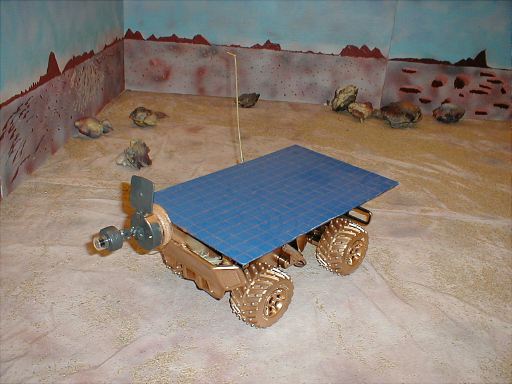






Selected Articles from the
June 2001
Odyssey
Editor: Terry Hancock
- ISDC 2001 Report, Seth Potter
- OASIS Brings Science to the Last Agamemcon Convention, Steve Bartlett
- The Surf Report, Diane Rhodes
OASIS Brings Science to Final Agamemcon Convention
Steve Bartlett
For the fourth year in a row, the Los Angeles NSS chapter provided a broad array of space and science programs at the Agamemcon science and science fiction convention over June 8 through June 10. Speakers from NASA, the space industry, academia, and the space activist community informed and amused the Burbank audience throughout the weekend. OASIS delivered over twenty hours of programming and activities at the last of the Agamemcon conventions, as well as staffing its large space information booth.
Mars Leads Programs
Mars exploration and settlement was a prominent theme in this year's programming lineup, with four separate programs on the Red Planet. Craig Peterson of the Jet Propulsion Laboratory (JPL) spoke on the advanced technologies under development to explore the Martian environment, including:
- Advanced communications networks to enhance data links to robotic probes.
- Improved propulsion systems to increase the mass delivered to Mars.
- New power systems to increase the range and performance of rovers and other devices
- New landing systems to ensure safe, soft delivery to the surface.
- New ways to travel on the surface and in the atmosphere of Mars to gain information unavailable to orbiting sensors.
Bob Gounley, also of JPL, gave a talk on planetary rovers, their features and operations. The talk featured a demonstration of the new OASIS Mars simulator rover on the miniature Marscape. Audience members operated the robot via remote control, using the on-board video camera to guide them around artificial Martian rocks and sand. Gounley discussed the Mars Pathfinder rover, which landed in 1997, as well as the Mars Odyssey rover now en route to the fourth planet and other planned rovers. He discussed the difficulties in operating and navigating a rover with limited communications coverage, the types of sensors used on rovers, the power and propulsion demands of a mobile system, and the idiosyncracies of working in the Martian environment.
 |
| Model of an operating Mars Rover. Photo courtesy Steve Bartlett. |
Webmaster's Note: Two galleries of AgamemCon V photographs are available in the Gallery section.
Both Peterson and Gounley spoke on the upcoming series of Mars exploration missions planned for the next decade. NASA, as well as the Europeans, Japanese, and others are building a gamut of systems bound for that planet. These include orbiters, rovers, surface penetrators, Martian satellite explorers, soil samplers, aircraft and balloons to learn more about our planetary neighbor.
NASA has acknowledged that the ultimate goal of its Mars program is to send humans to its surface. Unfortunately, it is doing little in the near-term to move the human program forward. To fill this gap, a number of private groups, including the Mars Society and the Space Frontier Foundation, have been pushing a humans-to-Mars agenda. John McKnight, former executive director of the Mars Society, spoke on the work underway in the Canadian arctic to simulate a human base on that planet. Dubbed the Flashline Mars Station, the privately financed facility on Devon Island includes a habitat, living quarters, life support systems, simulated manned rovers, power and other systems necessary for humans to survive in a remote, hostile environment.
[Read Part Two of the AgamemCon V Report]
File translated from TEX by TTH, version 2.25.
On 19 Aug 2001, 16:05.
Copyright © 1998-2003 Organization for the Advancement of Space Industrialization and Settlement. All Rights Reserved.